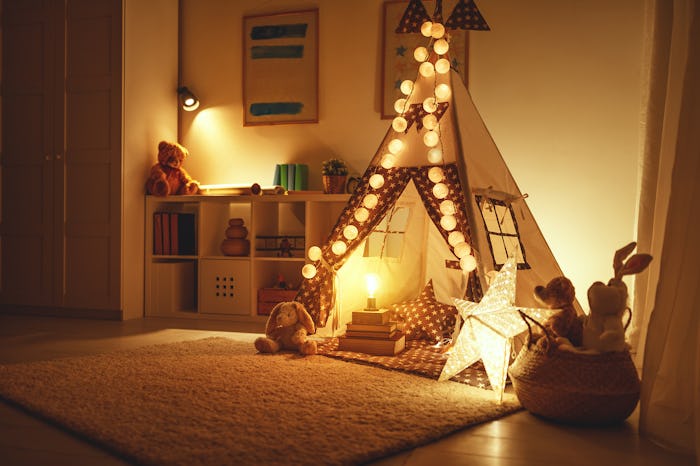Life

How To Organize A Playroom So Your Kid *Actually* Plays In It
When we first walked through our new house, my husband and I were thrilled to see a small sunroom off the living area — the perfect spot to turn into a playroom for our four boys. As their toys tend to multiply all over our home, I'd hoped that having one designated area would keep the rest of the house neater and encourage independent play. Unfortunately it didn't go according to plan. The kids almost never stay in there for long, but it's always a total mess. Can someone please teach a class on how to organize a play room so your kid actually plays in it? I would be the first to enroll, because I need help, STAT.
Luckily, there are people who have a much better grasp on these strategies than I do. When I reached out to The Goddard School advisory board member and curriculum specialist Lee Scott for help in organizing a playroom, I was overjoyed when she agreed to give me some tips worth passing along to other parents, too. Here's how to organize a playroom so that your kid actually plays in it, because locking them in is definitely not an option.
1Use Smart Storage
Scott recommends that parents purchase some cheap colorful bins or tubs in a variety of colors and sizes, and then sort the toys that you want your child to have easy and independent access to, putting them on the floor or on a shelf at eye level. Unless your kid is older, this isn't the place to put elaborate art supplies; instead, fill these bins with toy cars, dolls, or kid-friendly musical instruments.
2Make Books Accessible
Most children will spend time looking through books if they have convenient access to them (though in my experience, it has to be their own idea). Set up a small book shelf with some comfy seating nearby, or if you have extra bins left from above, feel free to use those, too. This is a great setup for board books, but you might consider keeping your favorite picture books on the family book shelf so they don't get ripped during play.
3Let Them Watch Themselves Play
I would have never thought of this one, but Scott suggests attaching a mirror to one wall so your child can watch himself while he plays. Infants and toddlers particularly enjoy this, she explains, because they are still pretty fascinated by what they see in the mirror. Bonus: it will also make the room seem bigger.
4Put Toys On Rotation
To keep the thrill alive, experts like Scott swear by rotating toys in and out of the room. Not only will this system minimize clutter and make it easier to find what they're looking for, old toys will feel fresh and exciting when they're pulled out of the storage they've waited in for three months.
5Introduce New Toys One At A Time
Yes, it might be difficult to do over the holidays, but to the best of your ability try to trickle in new toys slowly rather than dumping in a new load of overstimulation all at once and watching it all grow dull a week later. If you're given a bag of hand-me-downs from a friend, for example, put one toy in the playroom and the rest in storage. When the newness wears off, pull out the next one.
6Give Your Kid A Healthy Challenge
Little minds love a challenge, so long as it is truly within their capability, so don't be nervous to push them past their comfort zone. For example, Scott suggests, if your preschooler can confidently put together a 10-piece puzzle, put a few that are 15 or 20 pieces in the room and see what she does. You might both be surprised!
7Join Them
Yes, I know you were hoping for the playroom to be an independent area. And while it can be predominately that, that doesn't mean you can't join in the play and help your little one discover the world of possibilities at his fingertips. Sometimes children need to have toys modeled before they know how to use them. Have a comfortable chair or rug in the room — or something like this cushioned play mat from Nook— and you'll be more likely to join the fun.
Check out Romper's new video series, Bearing The Motherload, where disagreeing parents from different sides of an issue sit down with a mediator and talk about how to support (and not judge) each other’s parenting perspectives. New episodes air Mondays on Facebook.